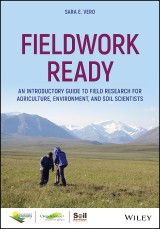Details

Fieldwork Ready
An Introductory Guide to Field Research for Agriculture, Environment, and Soil ScientistsASA, CSSA, and SSSA Books 1. Aufl.
|
47,99 € |
|
| Verlag: | Acsess |
| Format: | |
| Veröffentl.: | 01.03.2021 |
| ISBN/EAN: | 9780891183792 |
| Sprache: | englisch |
| Anzahl Seiten: | 272 |
DRM-geschütztes eBook, Sie benötigen z.B. Adobe Digital Editions und eine Adobe ID zum Lesen.
Beschreibungen
<p><b>Discover how to plan, conduct, and interpret field research with this essential new guidebook</b></p> <p>Good field research is the driving force behind advancement in the agronomic, environmental, and soil sciences. Nevertheless, many undergraduate and graduate scientists have limited opportunity to develop hands-on experience before undertaking projects in the field. With <i>Fieldwork Ready</i>, Dr Sara Vero maps out the fundamental principles, methods, and management techniques that underpin this crucial practice, offering trainee researchers an accessible introduction to the world of on-site investigation.</p> <p>This instructive text includes:</p> <ul> <li>Guidance on the essential aspects of environmental monitoring and soil, water, plant, and wildlife research</li> <li>Insights into the methods behind experiment planning and effective fieldwork</li> <li>Tips for team management and safety</li> <li>Explanations of how to select and correctly use soil sampling equipment</li> </ul> <p>Offering new researchers a primer that is practical and easy to follow, <i>Fieldwork Ready</i> is the ideal starting point for all those beginning a career in the agricultural sciences.</p>
<p>List of Photo Contributors xi</p> <p>Preface xii</p> <p>Acknowledgments xiii</p> <p><b>1 Introduction 1</b></p> <p>What is "Fieldwork?" 1</p> <p>Who Does Fieldwork? 5</p> <p>Why Am I Doing this? 8</p> <p>References 18</p> <p><b>2 Types of Fieldwork 19</b></p> <p>Experimental Design 19</p> <p>Plot Experiment 19</p> <p>Survey 22</p> <p>Case Study 24</p> <p>Monitoring 26</p> <p>Sampling Design 29</p> <p>Event Sampling 32</p> <p>Grab Versus Composite Sampling 33</p> <p>Sampling for Laboratory Studies 35</p> <p>References 35</p> <p><b>3 Preparation 37</b></p> <p>Site Selection 37</p> <p>Where Do I Need to Look? 37</p> <p>Risk Assessment 40</p> <p>Emergency 45</p> <p>Equipment 46</p> <p>Tools 46</p> <p>Consumables 49</p> <p>Maps, Apps, and Fieldsheets 49</p> <p>Local or Regional Maps 52</p> <p>Sketch Maps 52</p> <p>Plot Diagrams 53</p> <p>Mobile Apps 54</p> <p>Field Sheets 55</p> <p>Photographs 57</p> <p>Personal Protective Equipment (PPE) 61</p> <p>Vehicles 63</p> <p>Weather 68</p> <p>Target Conditions 68</p> <p>Precipitation 69</p> <p>Humidity and Temperature 70</p> <p>Wind 73</p> <p>Sunlight 73</p> <p>Soil Conditions 73</p> <p>River Conditions 75</p> <p>Concluding</p> <p>Remarks 76</p> <p>References 76</p> <p><b>4 Logistics 77</b></p> <p>Communication 77</p> <p>Your Team 79</p> <p>The Local Community 81</p> <p>Officials 82</p> <p>The Buddy System 83</p> <p>Checklists 85</p> <p>The Importance of the "Trial Run" 85</p> <p>In the Field 86</p> <p>Things Go Wrong! 87</p> <p>Delays 87</p> <p>Errors 88</p> <p>Standard Operating Procedures and Quality Control 89</p> <p>Accidents 90</p> <p>Vandalism, Theft, and Interference 93</p> <p>Moving On 93</p> <p>Taking Care of Yourself in the Field 94</p> <p>Dressing for the Field 94</p> <p>Hydration 99</p> <p>Food 100</p> <p>Toilet 101</p> <p>Moving in the Outdoors 102</p> <p>Fatigue 105</p> <p>Personal Safety 106</p> <p>Stress 107</p> <p>Accommodation 109</p> <p>Sample</p> <p>Management 110</p> <p>Packaging Samples 110</p> <p>Labeling 113</p> <p>Wildlife 114</p> <p>A Note on Insects 115</p> <p>Domestic Animals 116</p> <p>Zoonoses and Biosecurity 117</p> <p>References 121</p> <p><b>5 Environmental Monitoring 123</b></p> <p>Resolution, Precision, Accuracy, and Hysteresis 123</p> <p>Monitoring Arrays: An Overview 126</p> <p>Components 129</p> <p>Logger-Box or Enclosure 129</p> <p>The Data-Logger 129</p> <p>Power 132</p> <p>Power Calculation -- Example 136</p> <p>Sensors 138</p> <p>Air, Soil, and Water Temperature 138</p> <p>Stage 139</p> <p>Humidity 140</p> <p>Wind Speed 140</p> <p>Rain Gauges 140</p> <p>Volumetric Soil Water Content 142</p> <p>Matric Potential 144</p> <p>Step-by-Step Installation 145</p> <p>References 154</p> <p><b>6 Soil Techniques 157</b></p> <p>Soil Sampling Equipment 157</p> <p>Soil Survey 157</p> <p>Pore-Water Sampling 179</p> <p>References 181</p> <p><b>7 Water Techniques 182</b></p> <p>Surface Water Sampling -- Freshwater 183</p> <p>Instream Parameters 184</p> <p>Stream Width and Depth 184</p> <p>Physico-Chemical Parameters 186</p> <p>Using a Multiparameter Probe 187</p> <p>Sampling for Laboratory Analysis 190</p> <p>Autosamplers 193</p> <p>Sediment (Bed, Bank, and Water Column) 196</p> <p>Groundwater Sampling 203</p> <p>Microbial and Sterile Sampling 208</p> <p>Soil and Sediments 209</p> <p>Water 209</p> <p>Sample Preservation 210</p> <p>References 211</p> <p><b>8 Plants 213</b></p> <p>Finding a Slope 213</p> <p>Randomizing Plots 214</p> <p>Marking</p> <p>Field Plots 214</p> <p>Applying Treatment to Field Plots 216</p> <p>Phenology 219</p> <p>Wheat 220</p> <p>Corn 221</p> <p>Perennial Forage Grasses 222</p> <p>Soybeans 223</p> <p>Vegetation Sampling 224</p> <p>Root Sampling 231</p> <p>Plant Height 232</p> <p>Yield 235</p> <p>Forage Crops 235</p> <p>Grain Crops 238</p> <p>References 239</p> <p><b>9 Animal Techniques 242</b></p> <p>Live-Catch Trapping 242</p> <p>Use of Trail Cameras 247</p> <p>References 249</p>
<p><b>Sara E. Vero</b> is a lecturer in agricultural science at Waterford Institute of Technology, in Waterford, Ireland, with a background in soil physics, chemistry, water quality, and sustainability.</p>
<p><b>Discover how to plan, conduct, and interpret field research with this essential new guidebook</b></p> <p><p>Good field research is the driving force behind advancement in the agronomic, environmental, and soil sciences. Nevertheless, many undergraduate and graduate scientists have limited opportunity to develop hands-on experience before undertaking projects in the field. With Fieldwork Ready, Dr Sara Vero maps out the fundamental principles, methods, and management techniques that underpin this crucial practice, and offers trainee researchers an accessible introduction to the world of on-site investigation. <p>This instructive guidebook includes: <ul><li>Guidance on the essential aspects of environmental monitoring and soil, water, plant, and wildlife research</li> <li>Insights into the methods behind experiment planning and effective fieldwork</li> <li>Tips for team management and safety</li> <li>Explanations of how to select and correctly use soil sampling equipment</li></ul> <p>Offering new researchers a primer that is practical and easy to follow, <i>Fieldwork Ready</i> is the ideal starting point for all those beginning a career in the agricultural sciences.

















